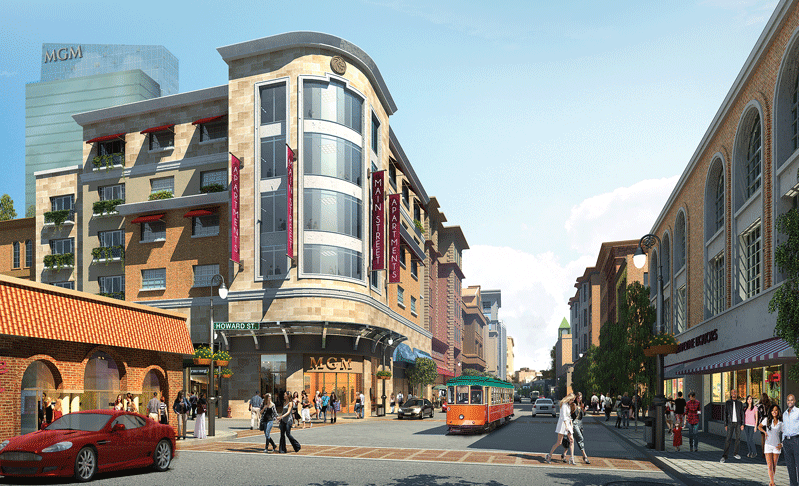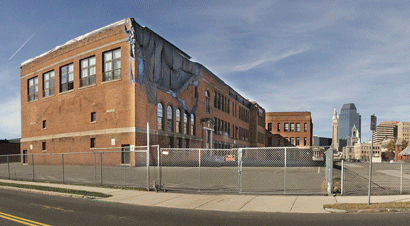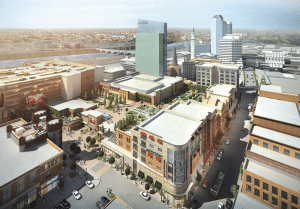Groundbreaking Events
MGM Springfield Set to Begin Changing the Landscape
 Mike Mathis wasn’t offering much by way of details.
Mike Mathis wasn’t offering much by way of details.
MGM Springfield is slated to stage a groundbreaking on March 24 for its $800 million casino complex in Springfield’s South End, and there is naturally widespread speculation about what’s on tap for that event, given the nature of the company staging the ceremony and an intriguing, more flashy time for groundbreaking ceremonies in general.
Indeed, recent events in Boston, which is witnessing an explosion in new construction, have featured everything from mimes to confetti cannons to mayors operating backhoes. Meanwhile, the casino industry has long been noted for its imagination and extravagance with such events.
Mathis, president of MGM Springfield, hinted that there might be something dramatic unfolding that morning on the grounds of the former Zanetti School, the first of several buildings that will come down over the next few months. But for the most part, he was, as might be expected, keeping things pretty close to the vest.
“We’re still finalizing some of the details. We’ll have a show — that’s all I want to say for now,” said Mathis. “We’re known for throwing good parties — and for keeping the details of those parties under wraps. Suffice to say, we won’t disappoint.”
He was, however, much more forthcoming about what will transpire after the ceremonies.
Indeed, after years of planning, formalizing its unique inside-out concept, negotiating with Springfield and a host of neighboring communities, and eventually winning the contest for the coveted Western Mass. casino license, MGM is finally set to begin altering the landscape — and in a number of ways.
But especially with the look and feel of several blocks within Springfield’s South End.
Things will start with the demolition of nearly 20 properties, starting with the tornado-damaged school, but then moving on to a host of buildings on State, Main, Howard, Bliss, and Union streets. And as structures start coming down, MGM’s huge parking garage, able to accommodate more than 3,000 cars, will start to go up, probably by this summer, said Mathis, adding that it is due to be ready for occupancy by the end of 2016.
The next structures to take shape will comprise what’s known as the project’s “podium,” meaning the low-rise buildings on the property, said Mathis, evoking an industry term. The signature hotel tower — 25 stories tall, according to the latest plans, and easily the most visible component of this complex — will be the last component to take shape.
As for the overall look of the project. Mathis said the phrase “final design” is not one that he’s comfortable using, because, well, things are far from final, and that state will continue to be a moving target in many respects.
“The concept continues to evolve,” he told BusinessWest. “There are certain elements that are fairly permanent, and there are others that we’ll continue to tweak; 90% of the project will stay largely the same as what we’ve shown in the past.”

The former Zanetti School on Howard Street will be the first of 19 buildings razed to make way for MGM Springfield.
“Technically, we could go into 2018 in terms of an outside date for getting this done,” he explained, “but we certainly want to get this project up and going as quickly as we can for the benefit of the city and the Commonwealth, as well as our company and our stockholders. We’re looking at a 33- to 34-month window that should put us into the fall of 2017.”
For this issue and its focus on commercial real estate, BusinessWest talked with Mathis about the next steps in this, the largest commercial project in the region’s history, and how and when the skyline will begin to change.
Razing Their Game
As he talked with BusinessWest from Las Vegas, where he still spends most of his time, Mathis joked that he hoped what the region has witnessed over the past 90 days or so constitutes what he called a “100-year winter,” and that it’s officially over by the time work commences March 24.
“I hope you’re getting it all out of the way before we really get going — and we don’t need another one like this,” he said with a laugh, noting that frequent snowstorms and bitter cold aren’t helpful when it comes to meeting a tight construction deadline.
But, then again, neither are the 120-degree days that frequent Las Vegas, he went on, adding that the company has worked through and around those while building the massive City Center project and other initiatives there.
“Las Vegas construction is as sophisticated as any in the country or the world,” he explained, while noting that the company is well-versed with large-scale projects and demanding timelines. “City Center was many times the size and cost of what we’re doing here. This [MGM Springfield] is well within our comfort zone in terms of scale.
“What makes it unique are the historical aspects and the New England environment,” he went on, adding that the company now has three projects underway simultaneously — MGM Springfield, the National Harbor project just outside Washington, D.C., and a large casino complex in Macau.
Overall, it’s been a busy four months of activity for MGM since the state’s voters turned aside a referendum question that would essentially have outlawed casinos in the Commonwealth.
As chronicled in the real-estate-transaction pages of this magazine, the company completed acquisition of the various properties it secured options on in 2013 and 2014, and then proceeded to issue notices to vacate to occupants of the buildings to be torn down or made part of the casino complex (see related story, page 44).
There have also been discussions and negotiations with the city’s Historical Commission regarding some of the properties in the footprint — including 73 Main St., the former Electric Light building, the Western Mass. Correctional Alcohol Center (formerly a YWCA) and its façade, and the State Armory on Howard Street — and some of those talks are ongoing.
“As always, this is about striking a balance,” Mathis explained, “and we’ve been recognized by the Gaming Commission for going above and beyond the work that many other developers would do in terms of incorporating historic buildings into the plan.”
As an example, he cited one recent tweak to the overall plan for MGM Springfield. Indeed, 95 State St., one of the properties vacated and scheduled to come down, will instead become part of the new casino complex, likely housing MGM administrative offices. Meanwhile, 101 State St., which was targeted for internal use, will instead be leased to outside tenants.
“The plan was to put our executive offices into 101 State, but that would not have left much capacity for other commercial tenants,” he explained. “Keeping 95 State is a significant step toward giving some capacity back to the downtown.”
As for the Correctional Alcohol Center, tests on that site have determined that the façade cannot be saved and the building will have to be razed, he noted, adding the MGM has proposed replicating some of its architectural elements elsewhere in the complex.
Demo Daze
MGM also named a general counsel — Seth Stratton, formerly with Fitzgerald Attorneys at Law, and, earlier this month, it named Brian Packer vice president of Development and Construction. In that capacity, he will provide executive oversight for all aspects of construction and program-management activities at MGM Springfield.
The company has also hired a construction manager, Tishman Construction of Boston, in a departure from the general-contractor model, said Mathis, a move that brings numerous advantages for the developer.

This aerial architect’s rendering shows the various elements of MGM Springfield, including the 25-story hotel tower.
Elaborating, he noted that a CM, as one is called, is traditionally brought into a project at the very beginning as a partner of sorts, handling every phase of the construction program, fielding bids, managing the job, crunching numbers, and devising ways to add value. A general contractor, meanwhile, is brought in after a full set of finished architectural and engineering drawings have been created. The GC then bids out the various components of the job and presents the client with one final number.
In the CM model, MGM will have greater flexibility when it comes to parceling out in the work in various-sized packages, or “spreading the wealth,” as Mathis put it, especially among local firms.
“We don’t intend to give the entire project to one general contractor that would then typically bring in their own established teams of subcontractors — the traditional list of people they would go to,” he explained. “This [CM model]gives us the ability to break the project up into components and allow smaller packages for more local opportunities.”
As one example of this, he cited the demolition work soon to commence at the former Zanetti School and other buildings in the casino footprint. Rather than include the fencing that accompanies such work in the demolition package, that item has been kept separate, giving more companies, and especially those in the 413 area code, a slice of the pie.
“Not surprisingly, there’s a pent-up desire for a health capital project like this one,” he explained. “We’ve done general notices on certain construction packages for demolition, excavation, fencing, and other elements of this work because we want to make sure we reach as many different companies as we can about the various opportunities.
“We’re going to work hard to create smaller packages, which is somewhat unique,” he went on. “We’re customizing things to this market to provide as many opportunities to different contractors as we can. There will be smaller, less-lucrative single packages, but we’ll be able to touch more smaller businesses this way.”
Building Momentum
While the specifics of the March 24 groundbreaking remain a closely guarded secret, the company’s plans, as Mathis said, will not disappoint.
And it will certainly work to make sure the same can be said for each aspect of the project — from the design to the construction timeline, to the opportunities for local business to share in the wealth from the $800 million.
Whether all that goes as planned remains to be seen, but one thing is certain: the landscape is going to start changing, and in some very big ways.
George O’Brien can be reached at [email protected]





